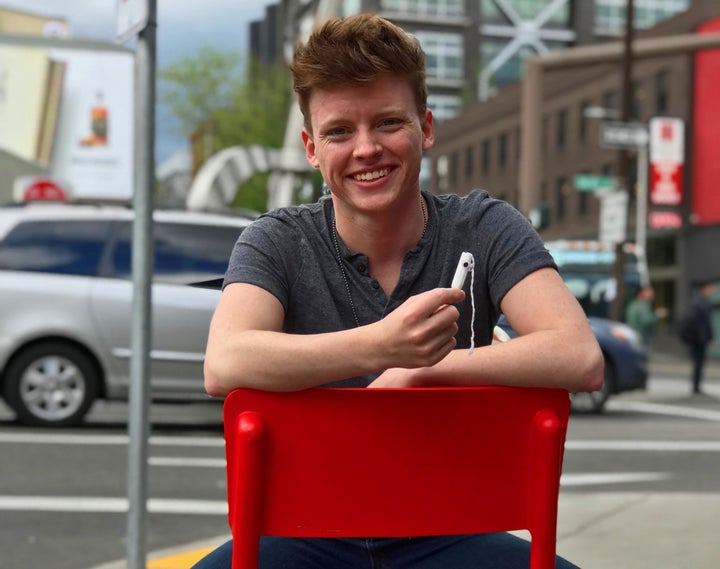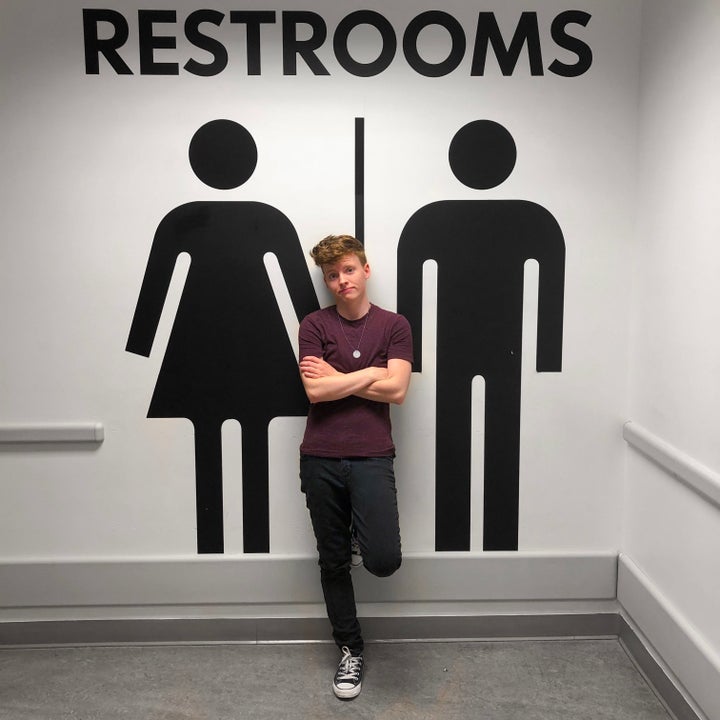Have you ever been in a bathroom stall and needed to throw away a used tampon or pad, but realized there was nowhere to put it?
I have ― almost every single day that I have my period. Why? Because I use the men’s bathroom.
I am a nonbinary trans menstruator ― someone with a uterus that bleeds monthly, but who identifies outside of the fixed categories of male and female. Because of that, I have to navigate the challenges of getting my period every month in a world that refuses to acknowledge that not everyone who gets their period is a woman, and not every woman gets their period.

I figured out that I was nonbinary when I was a little kid ― I just didn’t have the language or terminology to be able to name exactly who I was. I have very distinct memories of running around topless outside when I was 5, knowing that I wasn’t quite a girl, but also that I wasn’t a boy either. I fell in love with the term “tomboy” the very first time it was ever used to describe me and I clung onto the label like a life preserver until I turned 14 ― the age when it was no longer “cute” to shun growing into a girl.
But out of all of the awkward moments I faced while growing into myself, it was getting my period that marked this transition the most distinctly for me. I saw my stained underwear like a bloodied flag of surrender I was forced to fly as I left behind the freedom of childhood androgyny. As my breasts grew and my hips widened, I started feeling discomfort with my body’s changes ― discomfort that went far beyond the standard awkwardness of adolescence. Though I now can name these increasing anxieties as “dysphoria,” a term used to describe the common experience trans people often feel because our bodies do not match our gender, back then all I knew was that there must be something seriously wrong with me for not wanting to become a woman.
Now that I’m 25, I’m fairly comfortable in my skin ― about as comfortable as someone who doesn’t identify as female can be when you have two lumps of muscle and fat hanging off your chest and a gnawing feeling that everyone is analyzing you to try and figure out what category you belong in. I never did grow out of that tomboy phase, but I also never grew into wanting to become an actual boy. I’m neither and that works just fine with me; my ideal body is one that turns the idea of gender on its head and blends the false line between woman and man. I am happiest when I am living in the in between.

But what does a nonbinary trans person do when our period comes rolling around once each month and instantly reminds us that no matter how hard we try much of the world will still see us as women just because we get our periods? The persistent gendered messages I regularly encounter hit me like thousands of metal slivers piercing through my skin: the feminine hygiene signs, the lack of disposal bins in men’s restrooms, the sanitized advertisements featuring thin white women preserving their femininity with dainty white pads and periwinkle “blood.”
The representation of periods in the media has never matched the reality, but that’s even more true when you’re a trans person just looking for something that doesn’t scream, “You’re a W-O-M-A-N.”
When I run out of products, I have to go looking for a pad, tampon or even a cup that’s not awash in the traditionally feminine coding of pinks, purples and flowers. I slink down under the gaze of those “Feminine Hygiene” signs at Target, CVS and Walgreens and try to grab anything that won’t make my period dysphoria worse. If you thought just having cramps and mood swings was bad, try experiencing all of that while literally having a sign hanging over your head telling everyone around you that you don’t belong.
Once I have the products that I need, I have to figure out a way to change out my used products with the new ones. Before I started transitioning, if I couldn’t find a gender-neutral toilet, I would just use the women’s bathroom during my period because it was safer for me to be in there if my menstrual cup dropped on the ground or someone heard the sound of me opening a tampon or pad. Not to mention, women’s bathrooms have disposal bins and private stalls where you can deal with your menstrual blood without fear of being outed.
“What does a nonbinary trans person do when our period comes rolling around once each month and instantly reminds us that no matter how hard we try much of the world will still see us as women just because we get our periods?”
But now that my appearance has tipped the scale toward masculine, I’ve found myself ushered out of a lot women’s bathrooms by moms with young daughters, as if I’m inherently dangerous or being trans is a disease they could catch from breathing in the same air as me. On the flip side, using the men’s restroom means that I have to pray that I’m not already leaking when I walk in there and figure out the best ways to keep myself safe while discreetly tending to my period.
Dysphoria is also an incredibly difficult issue for trans menstruators to grapple with, particularly while our bodies are enduring significant physical and hormonal changes that come with our menstrual cycles. My worst experiences with dysphoria have always come during my periods ― not because I have to deal with the bleeding, but because my chest swells up significantly. For cisgender women who menstruate, tenderness and swelling of the chest can be an uncomfortable, but unseen part of having a period; but for trans menstruators, the effects are a bit more complex.
As someone with a petite body and a chest that was once measured as a 32C, period swelling makes my chest stick out significantly further away my body and that makes it difficult for me to bind that part of my body. Binding is something a lot of transmen and nonbinary menstruators do to flatten our chests if we have not had top surgery. Personally, I bind because the sight of my chest pushing out against my shirt makes me feel as if the world is seeing someone I am not. My breasts feel like incongruous growths that do not belong on my body –- like giant skin tags that have nothing to do with who I am. Until I can get them removed, the only way to make myself feel more at home in my own body is to press them down, making my chest as flat as possible. To do this, I use what’s called a binder, a specially made article of clothing that looks like a much tighter cross between a tank top and a sports bra.
The binders I normally wear are too tight to contain my period-swelled chest, so I usually have to revert to a larger size or a sports bra, which means my chest is significantly less flattened and I am more likely to be read as a woman and misgendered. Dealing with periods on their own are hard enough without my own gender being called into question due to the physical side effects of the menstruation experience.

Now, some people, at this point, would just encourage me to get a hysterectomy ― as if it’s as simple as walking into a doctor’s office and just ordering the procedure off a menu. Apparently, it’s easier to ask an entire community to undergo major surgery than for other folks to just stop gendering periods and let us menstruate in peace.
Others wonder why I don’t start taking testosterone, as many trans men and some nonbinary people do. But even if anyone who wanted the hormone could magically get it today for free, no questions asked, testosterone still isn’t guaranteed to completely halt a menstrual cycle. There is simply not enough research on the impact of testosterone and whether or not it causes a cessation of a cycle depends on what type or brand a person is using, how often a person takes it, and what dosage they are prescribed.
As a nonbinary person, I prefer to maintain a low dose of testosterone when I’m taking it, which generally means my periods are less likely to disappear than if I were on a higher dose. When I was on testosterone from October 2017 through March 2018, I got my period almost every single month and one time I got it twice in four weeks. Not only did the testosterone not stop my periods, the hormone actually made my symptoms much worse. Whereas before I used to be able to reliably count on my period arriving regularly and lasting for three to four days with a consistently light flow, after two months of being on testosterone, I started experiencing unpredictable periods, heavy cramping, and a relentlessly heavy flow that continued for almost seven full days.
Had I continued my weekly shots, which I stopped because of issues with my health insurance, my periods may have eventually ceased. But there are still countless stories of folks continuing to experience their periods even after being on testosterone for years, especially if they were on a low dose like me. On top of that, not all nonbinary or trans people want testosterone. Even if they do want it, not everyone can access it.

Activism around periods has started to pick up some serious steam lately, especially since 2015, which NPR dubbed the “Year of the Period” due to the exponential increase in headlines featuring the menstrual taboo, from the fight against the tampon tax to the right to free-bleed in public. But like any other publicized movement in history, it has become clear that the most marginalized voices have been left out of the conversation. For a movement which is based in the desire to be free of judgment, free of stigmatization and bodily control, it’s counterintuitive that we would not also consider the additional challenges that come with #BleedingWhileTrans, a hashtag I coined in 2017 to demand visibility for my community.
Though it may be easier to convince the public to accept a sanitized version of the fight for menstrual equity ― just as it’s easier for companies to advertise pads with the skinny white woman and her dainty pads ― at the end of the day, we cannot effectively rid the world of the period taboo unless we are doing so for all menstruators. Those of us who get our periods while not identifying as women deserve the same safety, access and comfort as anyone else who is menstruating. All that I want is to be able to walk into a store and buy tampons free of judgment, to change out my pads without worrying about my own safety in the bathroom, and to be included in a conversation that deeply impacts the body that I was born in, regardless of whether or not I am a woman.
Cass Bliss is a nonbinary trans educator with a passion for the creative. A storyteller at heart, Cass uses art, music, writing, and comics to raise awareness for unique issues facing the trans and nonbinary community, from trans-exclusive sex education and gendered periods to medical transitioning and transphobia. After publishing the first-ever period coloring book called “The Adventures of Toni the Tampon” and launching a viral campaign called #BleedingWhileTrans, Cass earned the moniker “The Period Prince” and established themselves as one of the leading experts in trans-inclusive period activism.
Do you have a compelling personal story you’d like to see published on HuffPost? Find out what we’re looking for here and send us a pitch!
